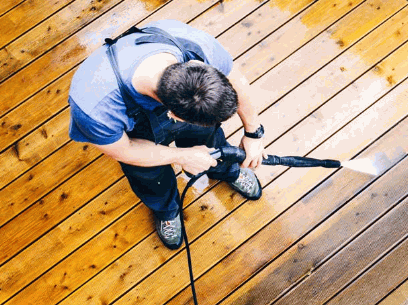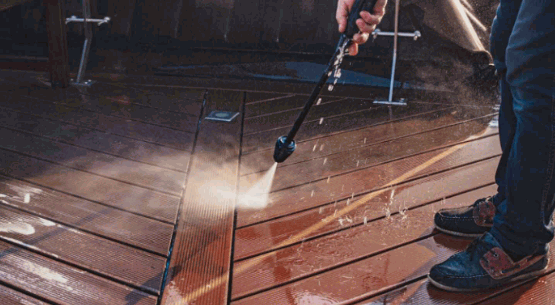
Pressure washing, also known as power washing, is an effective way to rejuvenate outdoor spaces, and your wood deck is no exception.
Over time, dirt, mold, grime, and mildew can accumulate, dulling its appearance and even affecting its longevity.
This guide explores the details of pressure washing a deck, including its benefits, essential tools, step-by-step instructions, safety precautions, and expert pressure washing tips.
Whether you're a DIY enthusiast or a homeowner looking to enhance your deck's appeal, you’ll find insights to help you achieve remarkable results. It's a great DIY project for those invested in home improvement and deck maintenance.
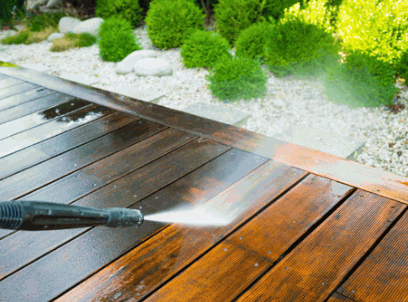
Table of Contents
Pressure washing, also known as power washing, is an effective outdoor cleaning technique that utilises a high-pressure water spray to eliminate dirt, grime, mould, and mildew from various surfaces, making it particularly beneficial for maintaining areas like timber decks, patios, and driveways.
This process employs specialised equipment, including a pressure washer, which can be rented from places like B&Q, ensuring a thorough clean that enhances the aesthetics and longevity of outdoor structures.
Discover: Is Pressure Washing Good For Vinyl Siding
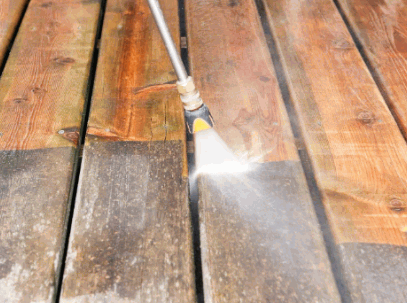
Pressure washing a wooden deck is essential for maintaining its integrity, appearance, and safety. Over time, decks can become a breeding ground for mould, mildew, and dirt, making regular deck cleaning necessary to ensure a safe outdoor space for family and friends. This process is particularly important for mildewed wood, which can become a safety hazard if not properly maintained.
Moreover, pressure washing not only rejuvenates the wood's appearance but also prepares it for deck refinishing or staining, ensuring better adherence to protective coatings.
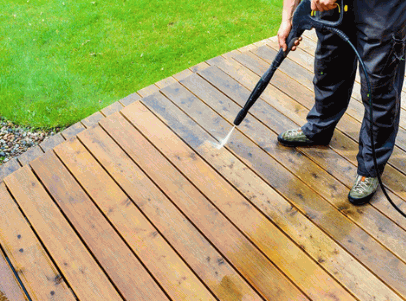
The benefits of pressure washing a deck are manifold, including the effective removal of dirt, mould, and mildew, which can deteriorate the wood over time. Utilising pressure washing as part of regular deck maintenance not only enhances the deck's appearance but also prepares it for restoration projects such as applying stain or protective coatings. Using appropriate cleaning agents ensures that the wood remains bright and inviting, making your outdoor space more enjoyable.
Regular pressure washing offers several key advantages that contribute to the longevity and visual appeal of your outdoor spaces. For instance, this cleaning method is a crucial aspect of outdoor maintenance that:
Selecting the right cleaning products tailored for deck materials is crucial. This ensures that while the deck is being thoroughly cleaned, it is not damaged in the process, maintaining its natural beauty and promoting a healthier environment. Cleaning agents like sodium hydroxide and wood brighteners can help in achieving optimal results.
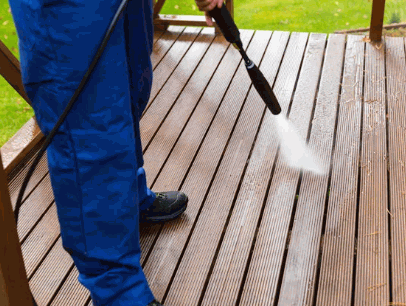
To effectively pressure wash a decking, several tools are essential, including a pressure washer, which is the cornerstone of the process, a suitable cleaning solution formulated for outdoor cleaning, and a deck scrub brush to tackle stubborn grime.
Additionally, using a decking brush assists in loosening stubborn dirt, while protective gear such as chemical-resistant gloves, safety goggles, and ear defenders ensures safety during the pressure washing process.
Having the right equipment not only streamlines the cleaning task but also enhances the overall effectiveness and environmental safety of the procedure. For instance, renting a pressure washer from Home Depot can offer a range of equipment options.
A pressure washer is the most critical tool for deck cleaning, delivering a high-pressure water spray that effectively removes dirt and grime from the deck surface. Choosing the right pressure washer can transform your outdoor cleaning tasks effortlessly. Whether you opt for electric or petrol-powered models, understanding pressure setting options can make a significant difference.
Regarding selecting the appropriate model, you’ll find various types that cater to different needs.
Consider factors such as pressure settings, usually measured in PSI (pounds per square inch), and flow rate, as these will significantly influence the effectiveness of the deck cleaning process.
For those who do not own a pressure washer, equipment rental options from stores like B&Q or Home Depot can be a practical solution, allowing access to a range of machines without the commitment of a purchase.
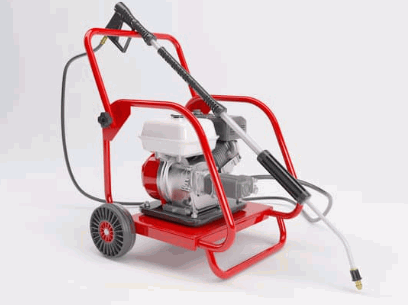
Using a suitable cleaning solution is paramount for an effective pressure washing process, as it helps in breaking down tough stains and dirt. Commonly used cleaning agents include sodium hydroxide for heavy-duty cleaning and deck brighteners to restore the wood's natural finish. Selecting the right cleaning products ensures that the deck is not only clean but also prepared for any refinishing or staining efforts post-cleaning. Always follow safety precautions and consider the environmental safety of the products you choose.
Choosing the appropriate cleaning solution is essential because it not only enhances the efficacy of the pressure-washing process but also protects the integrity of the surface being cleaned. For example, a high-quality deck stripper can help remove old finishes, and a chemical stripper can tackle tough grime. Regarding cleaning decks, options vary widely:
Ultimately, the selection of a cleaning solution should be based on the specific type of stains and the condition of the deck, ensuring optimal results and longevity of the surface. For environmentally conscious homeowners, there are eco-friendly solutions that provide effective cleaning without harmful chemicals.
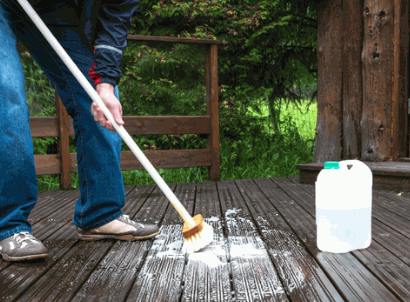
When pressure washing a deck, wearing appropriate protective gear is essential to ensure safety throughout the cleaning process. Key items include chemical-resistant gloves to protect hands from cleaning agents, safety goggles to shield eyes from debris and cleaning solutions, and ear defenders if using a particularly loud pressure washer. By adhering to safety precautions, you minimise the risk of injury and ensure a smoother, more efficient cleaning experience.
Equipping oneself with the right protective gear is not just good practice; it's necessary for preventing accidents that could occur due to splashes, flying particles, or loud machinery. Along with chemical-resistant gloves and safety goggles,
should also be part of the safety ensemble. This multi-layered approach to safety ensures that all potential hazards are addressed effectively, allowing for a more comfortable and worry-free washing experience while maintaining the integrity of the deck. Following the best safety practices not only helps prevent injuries but also contributes to environmental safety by minimising the spread of potentially harmful cleaning chemicals.

A scrubbing brush plays a vital role in the decking cleaning process, especially for removing stubborn stains and dirt that the pressure washer alone may not eliminate. When combined with an appropriate cleaning solution, the scrubbing brush helps to ensure that cleaning decking boards is thorough and effective. Choosing the right brush with durable bristles can significantly enhance your decking maintenance efforts and prolong the life of the surface. Always consider using cleaning chemicals that are safe for the specific type of deck you have, whether it's a wood deck or a composite deck.
Utilising a scrubbing brush effectively requires some consideration of both the brush type and cleaning technique.
These simple yet crucial tips will ensure that your decking not only looks great but also remains protected against future wear and tear, making your deck care routine more effective.
Taking the time to carefully select the proper tools and methods can make all the difference in maintaining a beautiful, durable decking. Whether it's through professional power washing services or a DIY approach, the key is to apply the right techniques and products.
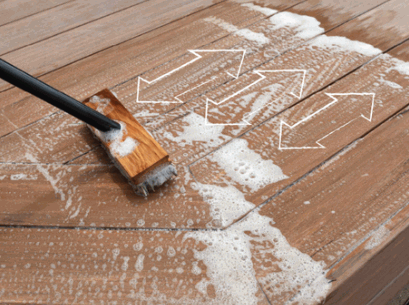
Effectively pressure washing a deck involves a systematic approach, starting with proper deck preparation and ensuring safety measures are in place before initiating the cleaning process. This includes gathering all necessary tools, selecting the right cleaning solution, determining the appropriate pressure washer settings, and addressing any sanding or refinishing needs post-cleaning.
By following these steps, you can ensure that the deck receives thorough cleaning while maintaining its integrity and enhancing its longevity. This also prepares the deck for subsequent treatments like staining wood or applying a deck coating to further protect and beautify the surface.
Preparing the deck is a crucial step in the pressure washing process, as it ensures that all loose debris, furniture, and obstacles are removed to facilitate effective cleaning. This may include sweeping the deck surface, removing planters or decorations, and covering nearby plants with dust sheets or drop cloths to protect them from cleaning chemicals and debris. Proper deck preparation not only promotes a thorough cleaning but also helps in maintaining the deck's overall integrity.
To achieve optimal results, it is essential to meticulously assess the deck area before beginning the pressure washing as part of your DIY project. Start by following these steps:
By taking the time to properly prepare the deck, the subsequent cleaning will be both efficient and minimally disruptive to the surrounding environment.
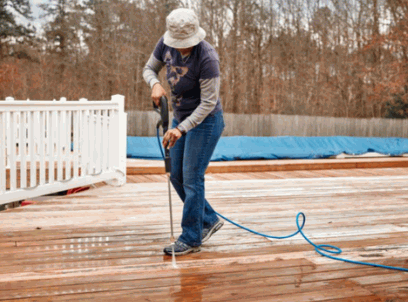
Selecting the right pressure washing equipment is essential for effective deck cleaning, as it determines how well dirt and grime are removed from the surface. Getting it right can save time, and effort, and ultimately lead to a cleaner, more appealing outdoor space. Consider factors such as the pressure setting required for your specific deck type, whether it’s a Wood Deck or Composite Deck, and the flow rate of the washer. If you do not own a pressure washer, you can opt for equipment rental from local stores like B&Q or Home Depot for one-off or short-term projects.
When choosing a pressure washer, it's crucial to evaluate the following criteria to ensure you have the right tool for the job:
Identifying the right specifications helps ensure you choose the best equipment, guaranteeing that your deck cleaning experience is both efficient and effective.
Mixing the right cleaning solution is a vital step in the pressure washing process, as it enhances the cleaning power against dirt and stains. A common approach is to use sodium hydroxide mixed with water to create an effective cleaning agent that targets tough grime on the deck surface. Always follow the manufacturer's instructions for dilution and application to ensure safety and effectiveness during the cleaning process. Consider using deck brightener or deck stripper for enhanced results.
To properly mix the cleaning solution, begin by measuring the recommended ratio of sodium hydroxide to water. Typically, this is around 1 cup of sodium hydroxide for every gallon of water, but it is crucial to verify specific guidelines provided by the manufacturer. Using safety gear such as gloves and goggles is essential to protect against chemical splashes.
For those looking to brighten the deck post-cleaning, consider using Oxalic Acid as a subsequent treatment. After mixing, let the solution sit for a few minutes before application to allow the active ingredients to activate effectively against grime and mould.
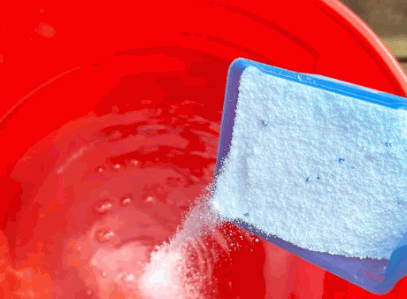
To start the pressure washing process, ensure that all equipment is set up correctly and that safety precautions are adhered to before turning on the pressure washer. Begin by selecting the right pressure washer nozzle, as different nozzles produce varying spray patterns and pressure levels, which are crucial for effective cleaning without damaging the deck surface. Keep a safe distance from the deck while working, and move in a steady pattern to ensure even coverage. For removing tough stains and dirt, consider using a specific deck cleaning solution.
Before diving into the actual cleaning, it’s imperative to not only choose the appropriate pressure washer nozzle but also to understand how to switch between them safely. While the
offers a narrow, high-pressure stream for tough spots, and the 25-degree nozzle provides a wider spray suited for more extensive areas. Conversely, the 40-degree nozzle is gentler and perfect for delicate surfaces. Ensure that you wear protective gear, including goggles and gloves, to shield yourself from debris and strong spray force.
After selecting the nozzle, position yourself about 2 feet away from the surface you are cleaning, angling the nozzle slightly for optimal results. Maintain a consistent motion—this prevents uneven cleaning and reduces the risk of damage to the deck. Remember to periodically check for any missed spots and adjust your approach accordingly. Allow for adequate drying time before applying any deck coating or finishes.
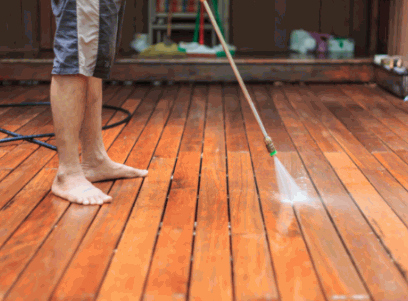
When engaging in pressure washing a deck, safety precautions are imperative to protect both the individual carrying out the work and the surrounding environment. This includes wearing appropriate protective gear such as safety goggles, ear defenders, and chemical-resistant gloves to shield against cleaning chemicals and debris. For those concerned with deck maintenance, consider additional resources such as deck restoration guides.
Additionally, ensuring environmental safety by managing runoff and avoiding harm to nearby plants or grass is critical for responsible outdoor cleaning.
Wearing protective gear is one of the most crucial safety precautions when pressure washing a deck, as it helps to prevent injuries and exposure to harmful cleaning agents. Essential gear includes safety goggles to protect your eyes from debris, rubber gloves to safeguard your hands from chemicals, and ear defenders to reduce the noise from the pressure washer. Ensuring that you are properly equipped will lead to a safer and more efficient cleaning experience. Additional safety measures include wearing protective clothing and using steel-toed boots to prevent foot injuries.
Along with the essential items already mentioned, there are several other types of protective gear that can significantly enhance safety during this task. Protective clothing made from water-resistant materials is vital as it reduces the risk of skin irritation from cleaning agents.
Ultimately, using the right equipment not only promotes safety but also improves overall efficiency, making the pressure-washing process both effective and secure. For more detailed guidance, you can visit places like Home Depot or B&Q for expert advice and equipment rental.
Utilising proper techniques during the pressure washing process is vital for both safety and effectiveness, as improper methods can lead to injury or damage to the deck surface. When embarking on a pressure washing project, it is essential to understand the nuances of this powerful cleaning method. Employing effective cleaning methods, such as using suitable detergents or cleaning solutions, further enhances results while ensuring the safety of both the user and the surface being treated.
When embarking on a pressure washing project, it is essential to understand the nuances of this powerful cleaning method.
Adjusting the pressure settings according to the specific material of the deck is crucial; for instance, wood often requires a lower setting compared to concrete to prevent gouging.
Employing effective cleaning methods, such as using suitable detergents or cleaning solutions, further enhances results while ensuring the safety of both the user and the surface being treated. When dealing with stubborn stains, cleaning deck boards with a garden hose before pressure washing can make the process more effective.
It is advisable to practise with the pressure washer on a less visible area before engaging in the main cleaning task. This preparation not only boosts confidence but also allows one to familiarise oneself with the machine's operation and the nuances of controlling water pressure effectively. Understanding the intricacies of the deck restoration process, from cleaning to finishing, can lead to a more successful outcome.
Being mindful of the surrounding area while pressure washing is essential for ensuring environmental safety and protecting nearby plants or structures from potential damage. Using drop cloths can help contain any runoff or debris, preventing them from affecting your garden or lawn. Keeping a safe distance from windows and delicate surfaces will minimise the risk of unintentional damage during the cleaning process.
To further enhance safety and protect your landscaping, consider the following strategies:
Applying protective barriers, such as mulch or stones, can fortify the area around your cleaning site. Taking these precautions will not only save you from potential costs associated with damage repair but will also reflect a considerate approach to maintaining your outdoor environment. For a comprehensive DIY project, consider using a Deck Stripper and Deck Brightener to enhance your deck's finish.
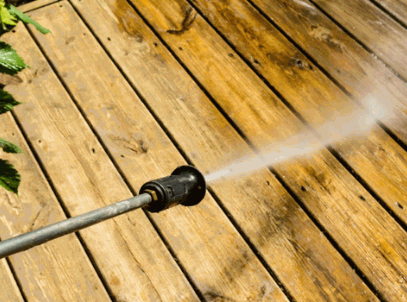
Determining how often a deck should be pressure washed depends on various factors, including the local climate, type of wood, and level of use. Generally, it is advisable to perform pressure washing at least once a year, but in areas with heavy rainfall or frequent use, more frequent cleaning may be necessary to prevent mildewed wood and other forms of deterioration.
Regular outdoor maintenance, including deck finishing and using products like Deck Coating from Home Depot, will help keep your deck in optimal condition.
Several factors should be considered when determining how often to pressure wash a deck, including the deck's exposure to the elements, foot traffic, and the presence of mould or stains. Deck maintenance tips can guide homeowners in identifying when a cleaning is necessary, such as checking for discolouration or a slippery surface, which indicates the buildup of dirt or mould. Utilising Deck Stripper and Deck Brightener can be effective in maintaining appearance and function.
Understanding these elements can significantly enhance the property’s longevity and visual appeal.
By being attentive to these indicators, one can establish an effective schedule for a thorough cleaning routine, ensuring a deck that remains both beautiful and functional.
The recommended frequency for pressure washing a deck typically ranges from once a year to twice a year, depending on environmental conditions, usage, and the type of decking material. For instance, wooden decks may require more frequent cleaning to prevent mould and mildew, whereas composite decks can withstand longer intervals between cleanings. Consistent deck maintenance helps prolong the life of the structure and keeps it looking fresh.
While maintaining the deck, it is crucial to consider various factors that influence cleaning frequency. For example, if the deck is situated in a shaded area, it may accumulate moisture more quickly, leading to increased chances of mildew. In contrast, a deck exposed to direct sunlight might dry faster but can also develop dirt and grime more readily from environmental exposure. Whether you have a wood deck or a composite deck, regular cleaning is essential to maintain its longevity.
Various
must be evaluated to establish the ideal cleaning schedule. Areas prone to heavy rainfall or snow might necessitate more frequent maintenance. Ultimately, a thorough inspection before each cleaning season will help determine the specific needs of the decking surface, ensuring it remains both functional and appealing.
